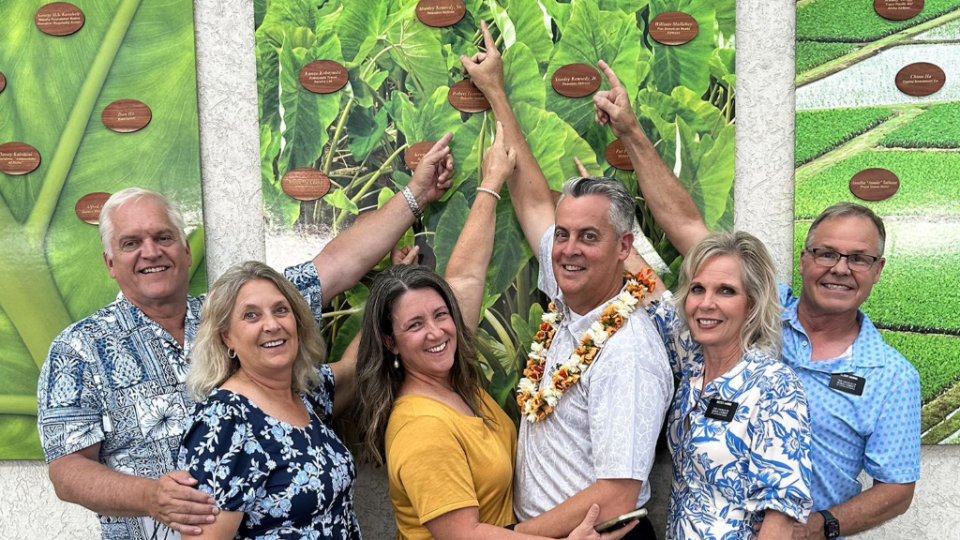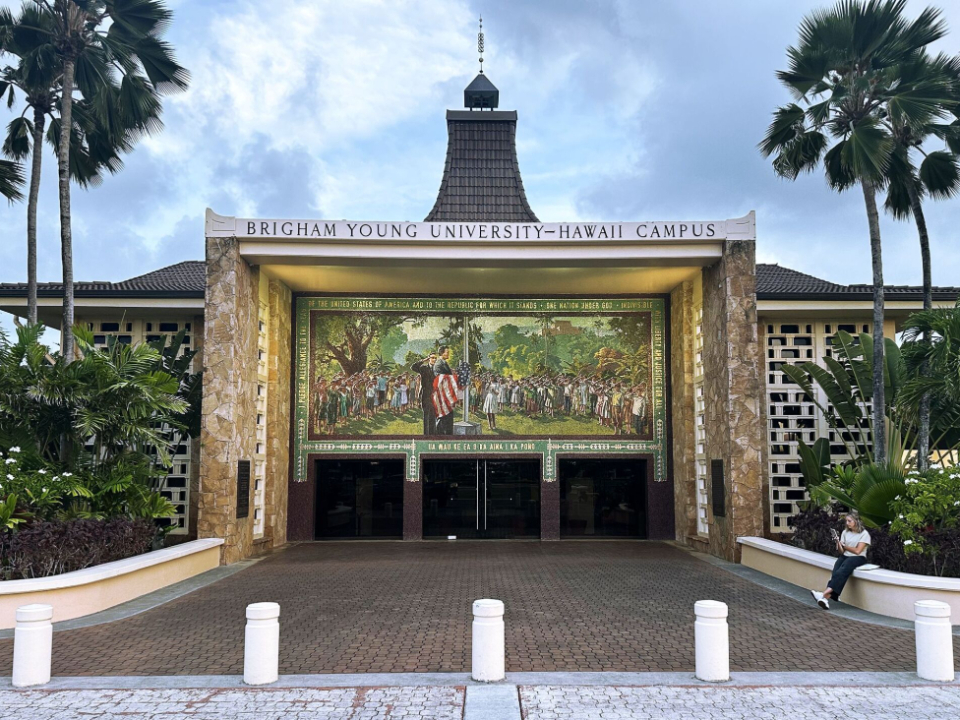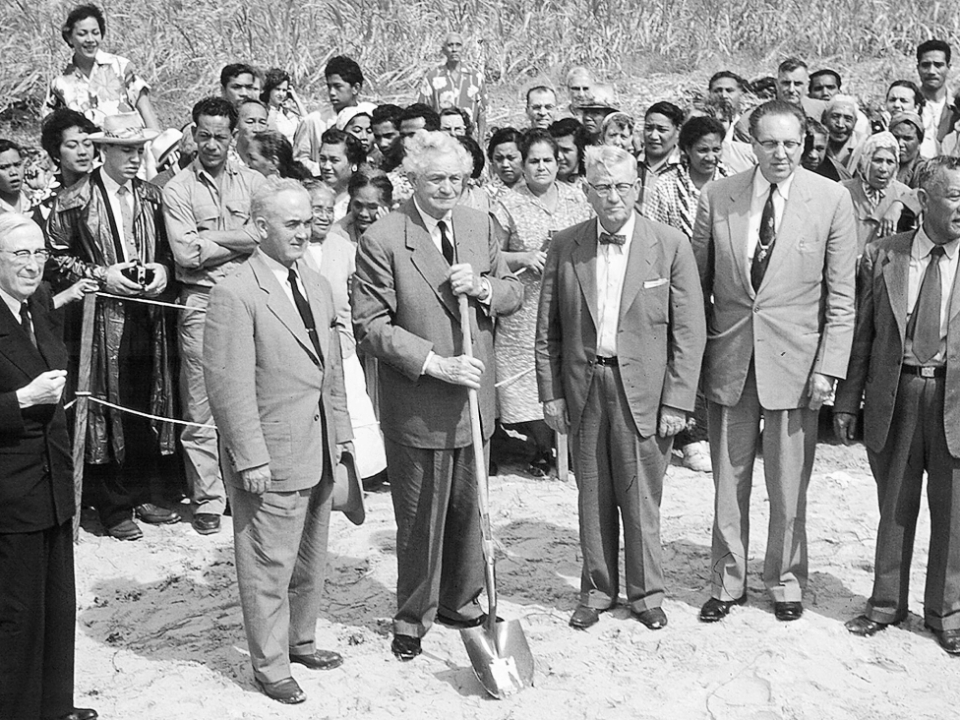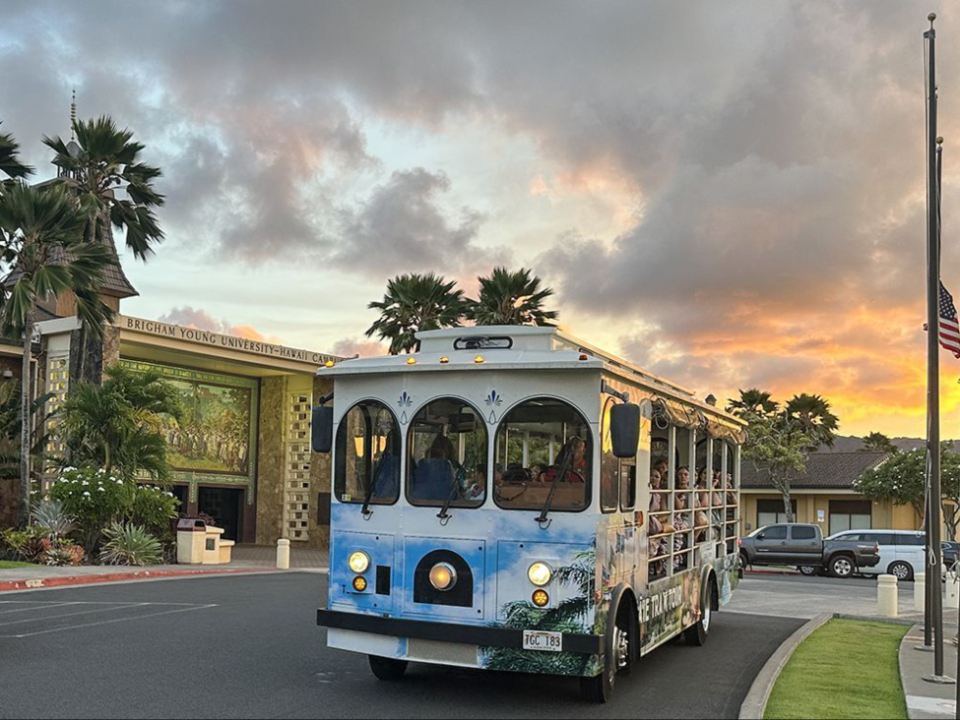
Hawaii's-Hall-of-Fame
Polynesian Cultural Center chief marketing officer and vice president Eric Workman, center, with his wife, Ann Chase Workman, were accompanied by senior missionaries Elder and Sister Archibald, left, and Elder and Sister Harris, right, to President David O. McKay’s induction ceremony into the Hawaii Hospitality Hall of Fame in the Hawaii State Convention Center in Waikiki on August 29, 2023. Photo courtesy of Polynesian Cultural Center, courtesy of Church News.All rights reserved.This story appears here courtesy of TheChurchNews.com. It is not for use by other media.
By Mike Foley, Church News
The School of Travel Industry Management at the University of Hawaii at Mānoa’s Shidler College of Business inducted President David O. McKay — the founder of the Polynesian Cultural Center — into its Hawaii Hospitality Hall of Fame on August 29 at the Hawai‘i State Convention Center in Waikiki.
Lee-Ann Choy, president of the School of Travel Industry Management alumni association which oversees the Hawaii Hospitality Hall of Fame, explained how the name of David O. McKay — a former educator who served as ninth president of The Church of Jesus Christ of Latter-day Saints, from 1951 until 1970 — is now listed among almost 50 others on a special wall.
“We are building a wall of the history of tourism in Hawaii,” she said of the “foundation these pioneers set for us. Only deceased inductees are honored.”

Hawaii's-Hall-of-Fame
The iconic Edward T. Grigware mosaic mural that graces the David O. McKay Building at Brigham Young University–Hawaii shows Elder McKay, then of the Quorum of the Twelve, and his traveling companion, Hugh J. Cannon, observing the flag-raising ceremony at the Church’s mission school in Laie on February 7, 1921. The experience is said to have inspired Elder McKay to foresee the need to establish a Church university in Laie, which happened in 1955. Photo by Mike Foley, courtesy of Church News.All rights reserved.Other inductees include hoteliers, restaurateurs, educators, tour and transportation executives, entertainers, cultural experts and more.
The Cultural Center’s chief marketing officer, vice president Eric Workman, and a small group represented President McKay at the hall of fame ceremony and banquet. “We were so pleased to hear the UH travel industry management alumni honored President McKay,” Workman said.
“There’s no question in any of our minds that he ‘championed’ the Church College of Hawaii, and subsequently the Polynesian Cultural Center, over many years in the history of Laie. We have all benefited from his vision and aloha for the Pacific and Asian people.”
President McKay’s History in Hawaii
In late 1920, Church leaders dispatched Elder McKay, then a young member of the Quorum of the Twelve Apostles, on a fact-finding tour of its Pacific islands and Asia missions and school systems, with the possibility of going on to Africa and Europe. During that almost-62,000-mile journey, for example, Elder McKay also visited China, Japan, Tahiti, Fiji, Samoa, Tonga, New Zealand, Australia, Indonesia, India, Palestine (i.e., Israel), Egypt, Armenia and Europe, arriving home on Christmas Eve 1921.
The early days of Elder McKay’s journey brought him to Hawaii where he witnessed Hawaiian and immigrant school children at the small mission school in Laie near the recently completed Laie Hawaii Temple raise the U.S. flag on February 7, 1921.

Hawaii's-Hall-of-Fame
President David O. McKay (holding the shovel) breaks ground for the new Church College of Hawaii on February 12, 1955. Labor missionaries soon after started building the permanent campus, while classes begin in temporary facilities that fall. Photo by Elder Lee Cantwell, from the BYU–Hawaii Archives, courtesy of Church News.All rights reserved.This sight ultimately inspired him, when he became president of the Church in 1951, to found Church schools in the South Pacific, the Church College of Hawaii in 1955 (renamed Brigham Young University–Hawaii in 1974), and the adjacent Polynesian Cultural Center in 1963 as a way to help more students from the Pacific islands and Asian Rim fund their college education.
At the university’s groundbreaking ceremony, President McKay predicted “millions of people” would eventually come to Laie, although at the time the total number of visitors to Hawaii was only slightly over 110,000. Since then, however, tourism became Hawaii’s leading industry, and almost 50 million visitors have experienced the Polynesian Cultural Center, making it one of Hawaii’s most popular attractions. President McKay’s foresight is also recognized for fostering the international growth of the Church.
While the Hawaii tourism industry is still recovering from economic impacts of the COVID-19 pandemic, BYU–Hawaii currently enrolls about 2,800 students from over 70 different countries. The Polynesian Cultural Center employs about 800 of those students in a unique, joint work-study program.

Hawaii's-Hall-of-Fame
The Polynesian Cultural Center optional free Laie Tour tram completes its stop at the BYU–Hawaii David O. McKay Building. The tour has been running since 1972 when then-Center administrator Norm Nielsen recommended it to boost attendance at the Laie Hawaii Temple Visitors’ Center. Photo by Mike Foley, courtesy of Church News.All rights reserved.Copyright 2023 Deseret News Publishing Company.